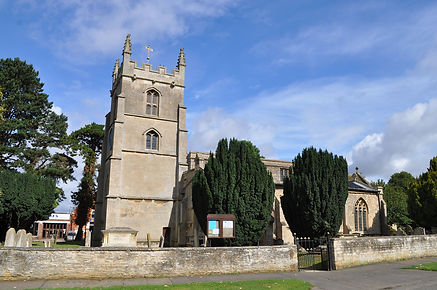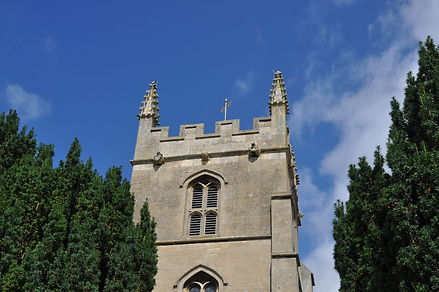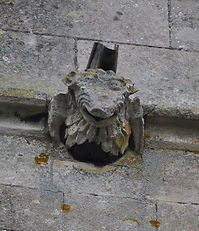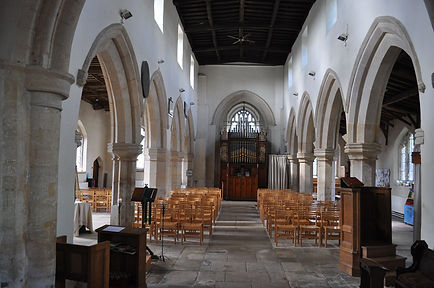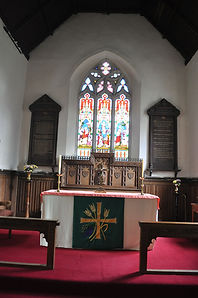BASTON : CHURCH OF ST JOHN THE BAPTIST.
Church Post Code PE6 9PE
The church here is normally open to visitors.
Baston is a village of approximately 1500 people at the time of the 2011 census, and is the most northerly church to be covered in this site, being 12 miles north west of Peterborough. Market Deeping is three miles off to the south east with Bourne five miles away to the north. There is a wealth of history here with King Street, an old Roman road, running just to the west of the village, a Roman soldier featuring on the village sign.
I have fond memories of this area, staying a few times near to Morton a little further north, using that as a base to cycle the churches in the vicinity. A lovely area, with friendly people and a fair number of open churches!
The church here is dedicated to St John the Baptist, and can be found tucked away a little from the main road. It consists of west tower, nave with north and south aisles and clerestories, south porch and chancel. It is thought that the earliest parts of this church date back to the early 13th century.
I had made several visits to the church here, and had been unlucky with the weather overall. One winter visit was on a bitterly cold day when I seriously doubted my sanity. One further visit saw the sun go in as I approached the church and stay in for the duration of my time spent there. The photographs here are from a bright, sunny day in September 2017. It was good to see the church bathed in sunshine and looking its best.
The west tower dates back to the 15th century and is heavily buttressed, battlemented and pinnacled. The church clock in the traditional colours of blue and gold is attached to the west face. Gargoyles surround the tower, including one with mouth wide open and two lower teeth, each of which is on the same side. To be fair, this is two more teeth than one close by, who grins happily, despite having the upper part of its head weathered away by the elements over a few hundred years.
The south aisle dates from the 14th century, with the north aisle dating from the 15th. The clerestory windows date from the 16th century. On several visits, I have never found this church closed, and as I arrived on this warm September afternoon, the door to the south porch was open. This is a friendly and welcoming church.
This south porch has an empty image niche over the top of the door, with an intricately carved surround, which I suspect has been empty since the reformation. On top of that is a very weathered sundial of considerable age. Two very weathered stone faces peer out at those approaching the south porch. One of these is frowning; the other is discernible as being human but is pretty much lost to us due to weathering. A frieze of repeated quatre foil design runs along the bottom of the porch.
There are stone heads scattered throughout the structure including what could well be a cat, with tongue stuck out. The tongue stuck out is normally scene as a gesture of insult but that is not the case here…it’s a cat! Some are more modern, dating from the time of the Victorian restoration. These include a crowned figure with long flowing hair and a figure with sightless eyes and impressive moustache
There are six bells in the ring here. The first of the ring is from Taylor of Loughborough, and is dated 1965. The second was cast by William Noone in 1703, who worked out of Nottingham. Interestingly, there is a very small bellcote to the west end of the south aisle, which is where a chapel to the guild of St Katherine was located.
The third of the ring was cast locally, by Tobias Norris III. The Norris family had a foundry in Stamford for around a hundred years, starting from the early years of the 17th century. This bell is dated 1694 and has the names Willian and Thomas Norton carved on to it. As with many of this founders bells’, the ‘N’s are the wrong way around.
The fourth of the ring is another from William Noone, which was originally cast in 1705 and inscribed ‘God save his church’. This was recast by Taylor in 1885. The fifth is courtesy of Edward Arnold of Leicester, dated 1797. This is inscribed with the name Richard Parkinson, who was the church warden of the day.
The sixth and final is another from Taylor, again in 1885. This is a recasting from another of Tobias Norris’ bells, which is inscribed Tobie Norris carved me 1693. There is a pub in Stamford called the Toby Norris, which was owned by the Norris family.
It was bright and welcoming inside; walls are whitewashed, with the only stained glass here coming at the east ends of chancel and south aisle. The sunlight took the chance to flood in as a result. It is interesting to see churches change over the years. Back on my first visit there were Victorian pews in place, these being replaced by modern stacking chairs.
There are four bay arcades to north and south, with these dating from the 13th century. The chancel arch is early 13th century, with the chancel itself an 1860’s rebuild. Looking to the west, the tower arch is 15th century and accommodates the organ.
There is a pleasing symmetry to the chancel, with commandment boards on either side of the altar; a wooden reredos has Christ in the act of blessing as the centre piece.
The stained glass east window depicts three scenes from the life of Christ. The first depicts Jesus surrounded by children, the second is the Ascension and the third is the raising of Lazarus. On this latter panel, Jesus points upwards; Mary and Martha praising God as their brother emerges from the tomb, with hands raised in prayer.
The second window can be seen at the east end of the south aisle. This is another three light window. On the left hand panel, the Archangel Michael holds the scales of judgment, wearing armour and holding a sword, which blade is made from flame. The right hand panel depicts St George, who stands on top of the vanquished dragon.
The central panel is the village war memorial. It depicts Christ crucified, with a soldier, deceased in battle. The soldier holds on to Jesus’ foot. The souls of each are shown in the symbolic form of two winged cherubs, which signify the safe passage of the soul to Heaven.






This south chapel had a semi circle of chairs around it, the altar has just a simple cross and candles, with four poppy wreaths mounted on to the east wall. In between them are memorials to those who fell in both wars. This appears to be a permanent arrangement as I noticed the same when I was here back in 2008.
The church grounds are tightly packed together; every inch of space being utilised. The graveyard was closed to new burials in 1909. There are some finely crafted gravestones to be seen here, but nothing of any great rarity. Two table tombs to members of the Norton family date back to the late 1780’s. Getting on for 90 years before, members of the same family were memorialised on one of the bells here. Obviously this was a family that had long standing connections with this church.
This page is being revised in January 2022. In pre covid days the church here was always open to visitors and I hope that the same can be said now. A glorious little church and a pleasure to have visited it!
If you would like to see the pages for some neighbouring villages ,please click on the photograph immediately above left to be taken to the page for Barholm. Click on the photograph immediately above right to be taken to the entry for Wilsthorpe. Each page will open up in a different window.
